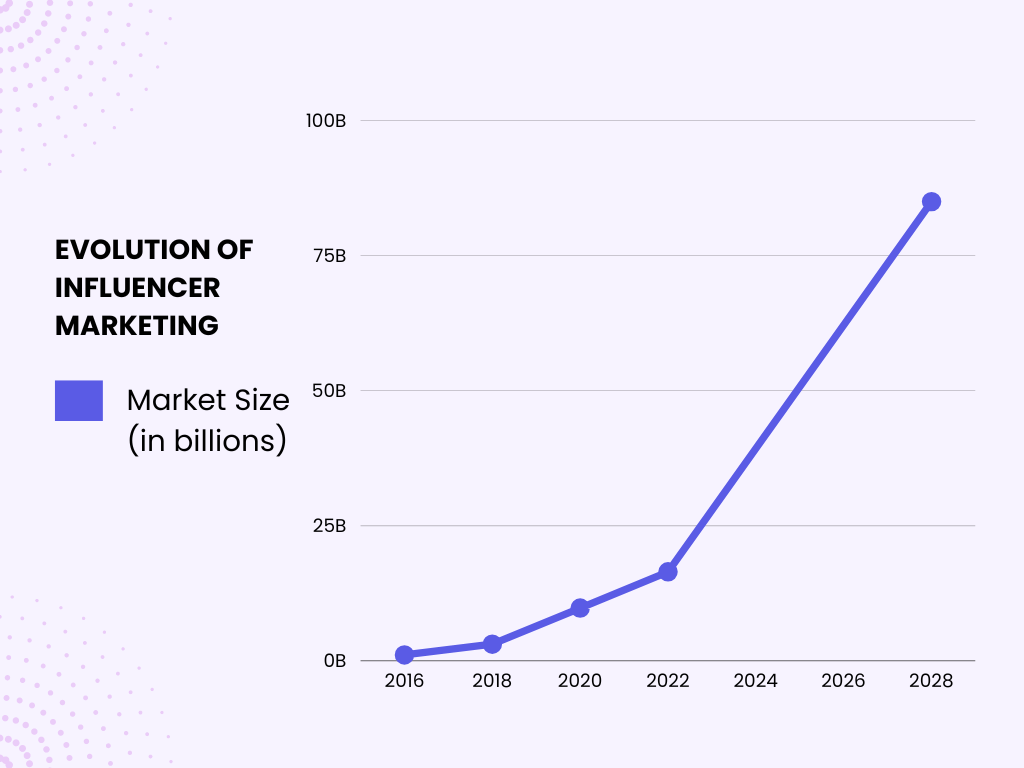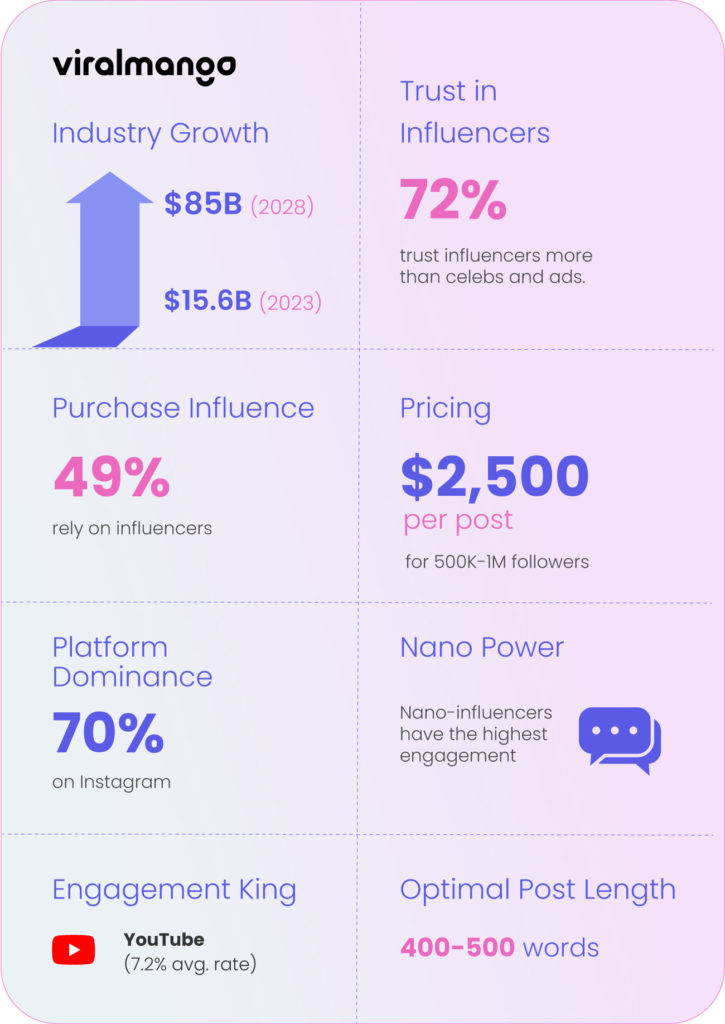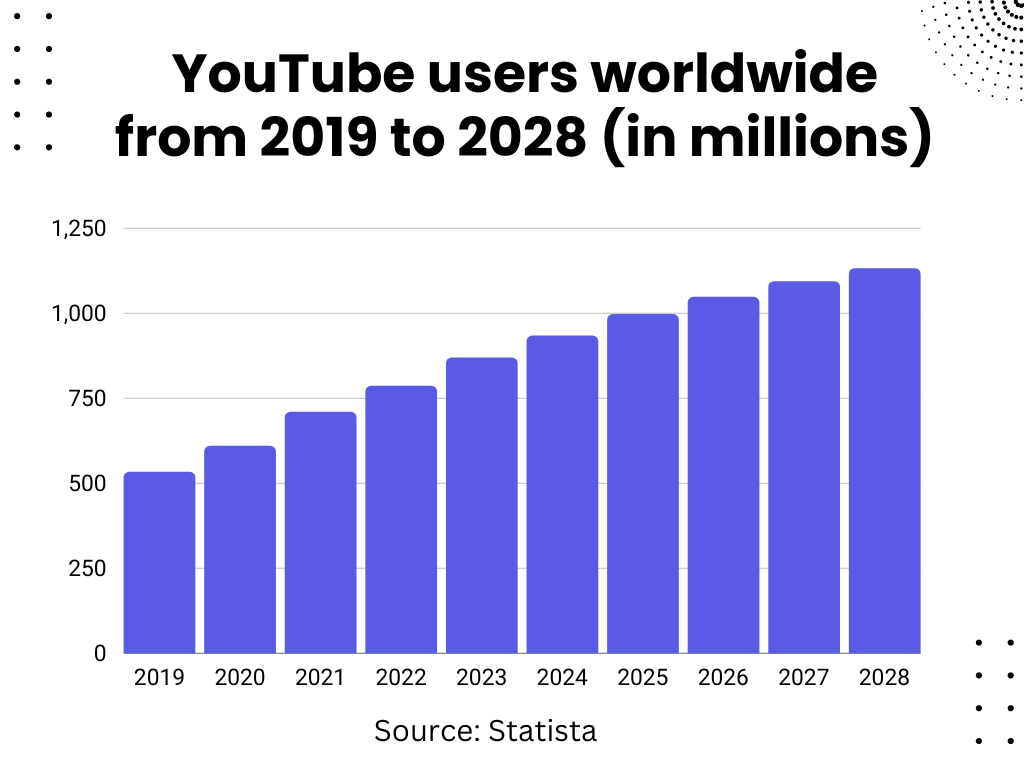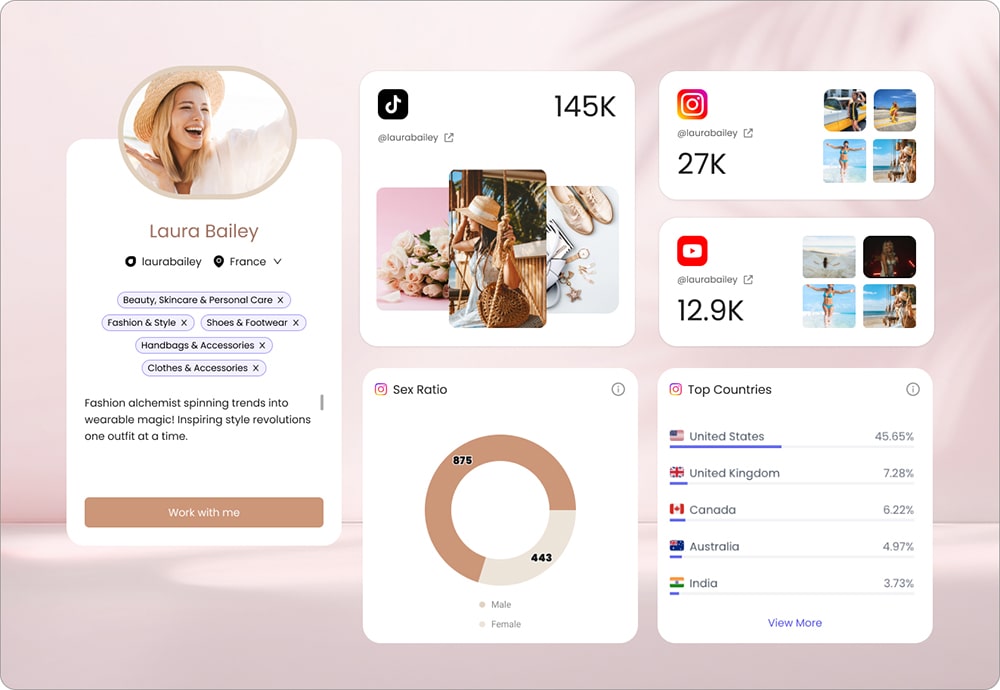Influencer marketing has cemented itself as one of the fastest growing digital marketing channels. By partnering with influencers – individuals with a strong online presence and targeted follower base – brands can tap into new demographics and amplify their messaging in an authentic way.
The rise of social media platforms has empowered individuals to become influencers, acting as a magnet for audiences that follow their lifestyle, opinions, and recommendations. These influencers often share a relationship of trust with their followers, which brands can tap into. However, in this ever-evolving world, it’s crucial for businesses and marketers to understand the statistics that drive this form of marketing.
This multi-billion dollar industry is projected to grow from $15.6 billion in 2024 to over $85 billion by 2028 according to the latest forecasts. It’s clear that influencer marketing delivers significant value in terms of reach, engagement, and ROI compared to traditional advertising.
In this comprehensive guide, we’ll explore the key statistics defining today’s influencer marketing landscape and the best strategies for brands to deploy successful influencer campaigns. This article aims to be your comprehensive guide, providing a 360-degree view of influencer marketing statistics, strategies, and expectations for 2024.
Why Influencer Marketing?

Remember the time when brands spent vast sums of money on celebrities to endorse their products in 30-second television commercials? While traditional advertising is still prevalent, a more nuanced and arguably effective approach has emerged in the form of influencer marketing.
Influencer marketing is defined as a form of social media marketing involving endorsements and messaging from influencers who have a dedicated following and expertise in a particular niche. Rather than direct advertising, influencer marketing aims to educate, entertain, and organically persuade audiences by leveraging the credibility of influencers.
Here’s why you should care: a study by Mediakix shows that the ROI from influencer marketing can be up to 11 times higher than traditional advertising methods like TV ads and banner ads. This dramatic difference in ROI can be attributed to several factors, such as authenticity, audience engagement, and trust.
The Rise of Influencer Marketing
Though word-of-mouth marketing has always existed, the rise of social networks over the past decade catalyzed the influencer marketing movement. Instagram in particular has been the driving force, now with over 1 billion monthly active users.
But YouTube, TikTok, Twitch, Snapchat, and other platforms host popular influencers in their own right. Tech startups also began facilitating influencer campaigns, providing tools for discovery, management, and analytics.
For brands, influencer marketing provides a way to tap into niche communities and demographics that are difficult to penetrate through conventional tactics. 72% of consumers now trust influencers more than traditional celebrities and brand ads.
So what does the influencer marketing landscape actually look like today? Let’s explore some eye-opening statistics.
Key Influencer Marketing Statistics for 2024

This data demonstrates the immense reach and engagement influencer marketing drives compared to organic brand posts and traditional advertising. Even at smaller scales, influencers are able to elicit responses from their loyal followers.
-
- The industry is estimated to be worth $13.8 billion in 2021 alone.
-
- Influencer marketing is expected to grow into a $85 billion dollar industry by 2028.
-
- Instagram remains the dominant platform, used for over 70% of influencer campaigns
-
- But YouTube actually drives the highest engagement, with 7.2% average engagement rate.
-
- Influencers have an engagement rate of 3.6% across platforms, compared to just 0.9% for brand-created content.
-
- 49% of consumers rely on influencer recommendations for their purchasing decisions.
-
- Influencers with 500K to 1 million followers can charge around $2,500 per sponsored post.
-
- However, nano-influencers with just 1,000 to 10,000 followers often have the highest engagement rates.
-
- The ideal influencer post length is between 400-500 words.
-
- CTAs and discounts lead to the highest conversion rates from influencer content.
-
- 89% of marketers say ROI from influencer marketing is comparable or better than other networks.
Overall Landscape
-
- As of 2024, estimates suggest that there are more than 500,000 active influencers globally, from micro-influencers to celebrity influencers.
-
- Brands are predicted to spend approximately $15 billion on influencer marketing by the end of the year, a steep rise from $8 billion in 2019.
-
- A staggering ROI measurement for influencer marketing is 5.2x on average, implying that for every dollar spent, brands are making more than five in return.
For more detailed statistics and sector-specific breakdowns, Influencer Marketing Hub offers an extensive range of insights.
Platform-Specific Statistics

Different social media platforms offer varied benefits and challenges. Here’s how they compare:
-
- Instagram: Currently the leading platform for influencer marketing with a 3.2% average engagement rate per post. Instagram is particularly popular among millennials and Gen Z, making it a hotspot for brands targeting the 18-34 age group.
-
- YouTube: With an average engagement rate of 2.4%, YouTube is another powerful platform, albeit with a broader demographic reach than Instagram. YouTube influencers often produce in-depth content, making it suitable for detailed product reviews.
-
- TikTok: The newcomer with exponential growth, TikTok has an average engagement rate of 1.5%. Although it may seem lower compared to its competitors, the virality factor on TikTok is incredibly high.
Industry-Specific Statistics
-
- Fashion & Beauty: These sectors dominate the influencer marketing scene. The average cost per post for a fashion brand is around $300, and the success rates in terms of audience engagement and ROI have been overwhelmingly positive.
-
- Tech: Interestingly, tech companies have reported a whopping 6.2x ROI on influencer marketing campaigns, despite a slightly higher average cost per post.
-
- Food & Beverage: Food influencers offer a great ROI, especially when the content includes recipe creation and cooking tips using the brand’s products.
For more industry-specific data, Statista provides a wealth of information.
Global Trends
The influencer marketing landscape also varies significantly by geography:
-
- North America: Brands here are the biggest spenders in influencer marketing, with the U.S. alone accounting for nearly half of the global influencer marketing spend.
-
- Europe: European brands are increasingly investing in influencer marketing, especially in the fashion and beauty sectors.
-
- Asia: The Asian market is diverse, with countries like Japan focusing on tech influencers and India showing a surge in lifestyle and travel influencers.
Influencer Marketing Strategies for Brands

For brands looking to run their first influencer campaigns, here are some proven influencer marketing strategies for success:
Identify Relevant Influencers The first step is discovering and analyzing influencers within your niche who create content aligned with your brand. Request a media kit and look beyond follower count; engagement, relevance, and audience demographic are just as important. Leverage influencer marketing platforms like ViralMango, Upfluence, Julius, or Amplify to discover and vet potential partners.
Establish Campaign Goals and KPIs Define what success metrics look like for your campaign and what you aim to achieve. Do you want to drive awareness, engagement, conversions, or a combination? Common KPIs include impressions, reach, clicks, engagement rate, conversions, and ROI.
Develop Authentic Relationships Approach influencers in an authentic way that respects their creative freedom. Don’t expect them to be a mouthpiece for your brand ads. Collaborate on campaign messaging and content strategy so it delivers value for their followers.
Manage Legal Requirements Have clear influencer contracts in place defining content usage rights, licensing, and payment terms compliant with FTC guidelines. Be transparent about sponsored content relationships and ensure proper disclosures.
Provide Detailed Briefs Give influencers detailed guidance on content type, formatting, tone, captions, hashtags, CTAs, etc. The more context you can provide, the better the output. But allow flexibility for influencers to inject their unique style.
Pay Fair Market Value Research industry rates based on follower count and content form when establishing your budget. Remember that high-quality influencers treat this as their full-time job. Pay fairly for the value they provide. Check out our Instagram Money Calculator to find out the fair rates for any influencer.
Leverage Multi-Channel Amplification Maximize your campaign investment by re-sharing influencer content across your brand channels. Repurpose content into ads, website posts, email newsletters, and more.
Track Performance Monitor campaign analytics regularly and gather feedback. Many platforms provide robust tracking of interactions, while manual check-ins ensure content remains visible online.
Evaluate and Optimize Learn from campaign performance to inform your ongoing influencer strategy. Double down on tactics that drive results and make adjustments where needed.
Influencer Marketing Challenges
While influencer marketing delivers outstanding ROI in many cases, marketers face some inherent challenges:
Fake Followers and Engagement
Some influencers artificially inflate their follower counts and engagement through paid services, bots, etc. This skews their perceived value. Examine authentic engagement metrics when vetting influencers. You can check influencer’s fake followers through Viralmango’s fake follower checker.
Content Moderation
Once published, you relinquish control over influencer content. Proactively vet influencers, provide guidelines, and monitor closely to ensure proper messaging. Have a backup plan if content must be removed.
Measuring True ROI
Determining influencer marketing campaign ROI beyond vanity metrics like reach and engagement requires tracking real business impact. Use UTMs, affiliate links, and promo codes to monitor conversions driven by influencers.
Brand Safety and Compliance
Negative or non-compliant influencer behavior can damage your brand reputation. Maintain strong relationships and contracts to align expectations. Outline processes for correcting issues.
Managing Complex Logistics
Running multi-channel influencer campaigns across different partners takes significant strategic coordination. Marketing automation platforms help streamline workflows.
Best Practices for Influencer Outreach

One of the most import elements of influencer marketing is establishing initial contact with potential partners. Use these proven tips to maximize response rates:
Personalize Outreach Target influencers one-by-one using their name and handle. Mass outreach is highly ineffective. Demonstrate you know the influencer’s niche and content style.
Craft a Specific Pitch Explain why you’re reaching out and what makes them a great fit for your campaign or brand. Provide potential hooks that pique their interest.
Keep Emails Concise Respect their busy schedule. Get to the point clearly and concisely. Include only necessary context and details in your initial email.
Offer Value Upfront Highlight what the partnership could do for their brand and community. Influencers prioritize working with brands that fuel valuable conversations.
Follow Up Politely Don’t take lack of response personally. Follow up politely after 1-2 weeks highlighting why you think the partnership makes sense.
Build Genuine Relationships View influencers as creative partners, not just promotional channels. Get to know them better through conversational outreach before formalizing campaigns.
Email Building and Contacting Influencers
Though social media platforms are essential for influencer marketing, never underestimate the power of a well-crafted email. Emails can be a more personal and direct way of reaching out to potential influencers for collaboration.
Building an Email List
You can start by following influencers in your industry and collecting their contact information. Several online tools allow you to scrape email addresses legally and compile them into a database.
Crafting an Effective Email Pitch
Once you have your list, the next step is to compose an engaging and compelling email. Utilize email newsletter pre-designed templates to make your pitch stand out. Remember to:
-
- Personalize the message
-
- Clearly state what you offer
-
- Explain what you expect in return
Avoiding Spam Filters
The last thing you want is for your meticulously crafted email to end up in the spam folder. To ensure better email deliverability, you may refer to Unspam’s comprehensive services and guide. Key tips include:
-
- Using a reputable email service
-
- Avoiding the use of spam trigger words like ‘free,’ ‘earn money,’ and so forth
The Future of Influencer Marketing

As more brands shift their budgets toward influencer marketing, the industry will continue evolving through 2024 and beyond. We can expect:
-
- Increased adoption across B2B companies and niche verticals
-
- Continued influencer platform consolidation and emergent startups
-
- Greater focus on standardized metrics like ROAS to quantify impact
-
- Micro and nano-influencers playing a bigger role for cost-efficient reach
-
- Tighter content regulation and enforcement by social platforms
-
- Influencer collectives gaining more monetization control
Upcoming Trends
As the industry matures, several trends are expected to gain prominence:
-
- Virtual Influencers: It’s projected that virtual influencers, who are entirely computer-generated, could make up 20% of the influencer market within the next two years.
-
- Transparency and Regulations: As consumers become more savvy, the demand for transparency is growing. This will likely lead to stricter regulations concerning disclosure and ethical considerations in influencer marketing.
Tracking and Monitoring Influencer Posts
Once an influencer has posted content related to your brand or product, it’s crucial to track the post’s performance and longevity. Ensure that the content aligns with your brand values and contractual obligations. Tools like Pulsetic can help you check if the posted content is accessible worldwide.
Conclusion
The influencer marketing bubble won’t burst anytime soon. But brands must stay nimble, transparent, and data-driven in their strategies. When executed properly, partnering with influencers provides unmatched ROI compared to other tactics.
Influencer marketing has experienced meteoric growth over the past decade and become a stalwart digital marketing channel. As the statistics and strategies outlined in this article demonstrate, collaborating with influencers allows brands to reach targeted demographics in an authentic way that resonates deeply.
When done right, influencer campaigns drive outstanding engagement rates, conversions, and overall ROI compared to traditional advertising and branded content alone. These collaborations succeed by forming genuine connections between influencers and their loyal followers, establishing trust and effectively promoting products or services through real-life usage and endorsements.
For brands, the keys to influencer marketing success include:
-
- Thoroughly researching and vetting potential influencer partners to find ideal brand alignments
-
- Setting clear campaign goals and KPIs to track performance against
-
- Developing organic relationships with influencers and granting them creative flexibility
-
- Structuring fair compensation in line with industry benchmarks
-
- Providing detailed guidance to influencers while allowing their unique personality to shine
-
- Amplifying and repurposing influencer content across marketing channels
-
- Monitoring engagement levels and optimize based on data and insights
While challenges like fake followers, noncompliant content, and logistical coordination exist, the upside far outweighs the risks.
As more companies shift their budgets to influencer programs, competition for top partners will intensify. Brands must build efficient workflows, demonstrate value to influencers, and focus on driving measurable business impact. When executed strategically, influencer marketing delivers unrivaled engagement and ROI that every brand should be leveraging as part of their social media marketing mix.
Reviewed By Rem Darbinyan
Revolutionizing industries with AI, Rem Darbinyan is the CEO of ViralMango and an entrepreneur, AI expert, and influencer marketing strategist.




